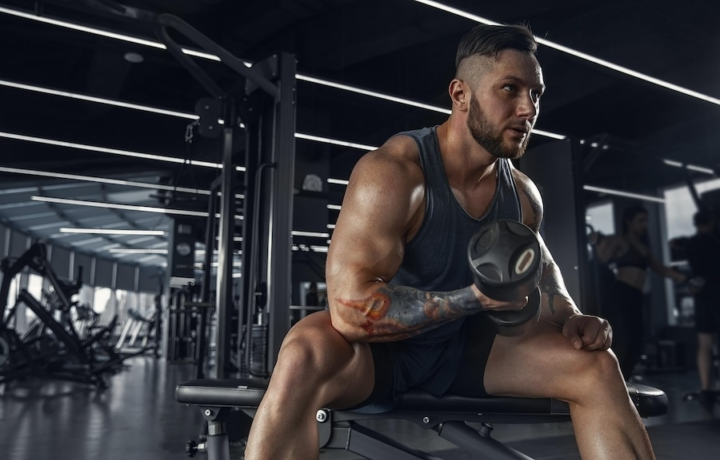Exercise
Cable Overhead Triceps Extension

Cable Overhead Triceps Extension
How to Perform
- Attach a rope or bar to a high cable pulley and grasp it with both hands, facing away from the machine.
- Position your feet shoulder-width apart, engage your core, and maintain a slight forward lean at the hips while keeping your back straight.
- Bring your hands behind your head with your elbows pointed toward the ceiling, creating the starting position with your triceps partially stretched.
- Inhale deeply and brace your core to stabilize your upper body throughout the movement.
- Exhale as you extend your elbows, pushing the rope or bar overhead until your arms are fully straight but not locked.
- Hold the contracted position for a brief moment, focusing on squeezing your triceps at the top of the movement.
- Inhale and slowly lower the attachment back to the starting position by bending at the elbows, keeping them pointed upward and close to your head.
- Maintain control throughout the negative portion, ensuring your wrists stay neutral and your shoulders remain down away from your ears.
Important information
- Keep your upper arms stationary and close to your head throughout the exercise, as only your forearms should move.
- Avoid arching your lower back by maintaining core engagement and a slight hip hinge position.
- Adjust the weight to allow for complete triceps extension without compromising form or causing your elbows to flare outward.
- If you experience any wrist discomfort, try using different attachments such as a V-bar for a more neutral grip position.

Cable Overhead Triceps Extension
Exercise Details
Primary Muscles
Muscle Groups
Mechanic
Risk Areas
Built for progress
Take the guesswork out of training
Create personalized AI-powered workout plans that evolve with you. Train smarter, track every rep and keep moving forward, one workout at a time.






The Cable Overhead Triceps Extension stands as a cornerstone movement for anyone serious about developing impressive triceps definition and functional pushing strength. This intermediate exercise targets the often-neglected long head of the triceps muscle, which contributes significantly to that coveted horseshoe appearance when properly developed.
Unlike some isolation movements, this exercise allows for consistent tension throughout the range of motion, making it particularly effective for bodybuilders seeking that detailed separation between muscle groups. The cable mechanism provides steady resistance that free weights simply can't match, challenging your triceps from a fully stretched position to complete contraction.
For strength enthusiasts, regular implementation of this movement can translate to improved performance in compound pushing exercises like bench press and military press. The stability demands of the overhead position also engage your core and shoulders as secondary stabilizers, creating a more integrated strength development approach while maintaining primary focus on the triceps.
When incorporated into a well-designed upper body routine, this exercise serves as an excellent finisher after heavier compound movements have pre-exhausted the larger muscle groups. Bodybuilders particularly appreciate how the exercise allows for precise control over the contraction and peak tension points, enabling that crucial mind-muscle connection that drives hypertrophy.
Many intermediate lifters find this movement bridges the gap between basic triceps work and more advanced techniques. The exercise responds well to various repetition schemes—whether you're pursuing the pump with higher reps or focusing on strength development with more moderate loading patterns.
What makes the Cable Overhead Triceps Extension particularly valuable in a strength program is its ability to strengthen the triceps in a position that mimics overhead pressing motions. This carryover effect can help break through plateaus in military press and other overhead movements where triceps strength often becomes the limiting factor.
FAQ - Cable Overhead Triceps Extension
This exercise primarily targets the long head of the triceps brachii, which is crucial for developing that coveted horseshoe appearance. It also engages your core and shoulders as secondary stabilizers, creating an integrated strength development approach while maintaining focus on triceps development.
Stand facing the cable machine with the ankle attachment secured, maintain a slight bend in your supporting leg, and keep your core engaged throughout the movement. Focus on driving the movement from your glutes rather than your lower back, and avoid arching or rounding your spine.
For optimal results, incorporate this exercise 1-2 times weekly as part of your push or arm-focused training days. Position it after compound movements like bench press or shoulder press when your triceps are pre-fatigued but not completely exhausted.
Avoid bending your elbows to compensate for limited shoulder mobility, as this negates the stretching benefits. Don't rush through repetitions or use momentum—move slowly and deliberately. Also, never force the movement beyond the point of mild discomfort, as this could lead to shoulder strain.
Beginners can start with lighter weight and higher reps (12-15) focusing on proper form. Intermediate lifters can progress to moderate weight in the 8-12 rep range. Advanced lifters can incorporate techniques like drop sets, slower negatives, or single-arm variations to increase intensity without compromising form.






